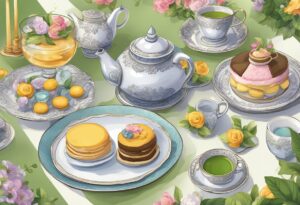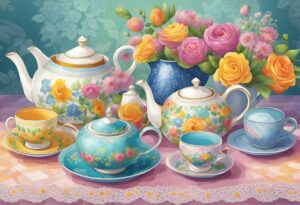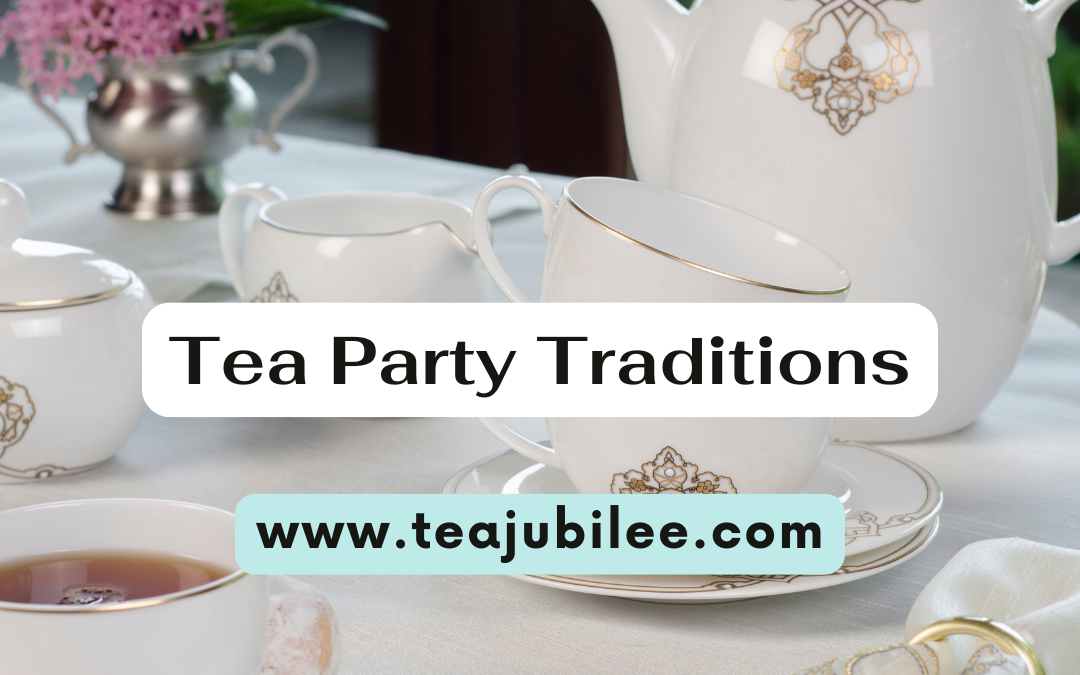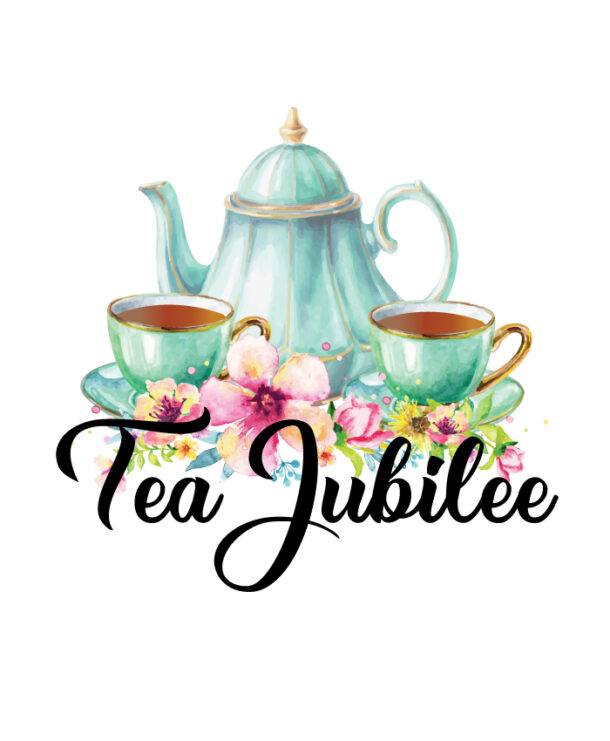==================
A Caveat and Affiliates
First off, a little caveat: within my articles you will find affiliate links, meaning if you buy them, I get a small commission. Your cost is not affected. In addition, I am an Amazon Associate and I earn from qualifying purchases on Amazon.
And yes, if I say that I recommend a product here, it means I truly believe it is a good product. I refuse to recommend any product that I have not researched and believe to be a good value.
Even better, I provide you with a very clear picture of the product, it’s use, and the probable value.
Earning your trust is important to me. I run this website myself and the commissions and donations help support the site.
Sound reasonable and fair enough? Let’s continue to the article.
==================
Contents
Tea Party Traditions:3 Great tea party ideas
Welcome to Tea Jubilee! Today, we will discuss Tea party Traditions and why they are essential to understand. Are you ready to dive into this post and learn about Tea Party Traditions? I am ready to take you to this post to help you learn more.
The world of tea parties started way back in ancient China. The Chinese were the first to discover tea, and it wasn’t long before they brewed it into something special. Invitations to taste and savor the different tea blends became standard in their social circles. This marked the beginning of tea as a beverage and an experience.

Tea culture made its way to Japan from China. It became even more profound with Chanoyu, or the Japanese tea ceremony. This wasn’t just about drinking tea; it was a meticulous ritual emphasizing harmony, respect, purity, and tranquility. Every movement in the ceremony held meaning, making it a profoundly spiritual experience.
Fast forward to the 17th century, when tea culture drifted into Europe. The Europeans, particularly the Dutch and Portuguese traders, were smitten with tea. It quickly became a fashionable beverage among the elite. By the mid-1600s, Parisian salons and English coffeehouses began serving tea, setting the stage for more formal tea gatherings.
Then came the 19th century in Britain, where afternoon tea was born. This was introduced by Anna, the Duchess of Bedford, who was getting peckish in the long stretch between lunch and dinner. Her simple act of inviting friends over for tea and snacks turned into a beloved British tradition that still stands strong today.
British Tea Party Traditions: A Royal Affair

In Britain, tea parties aren’t just a casual get-together; they’re an institution. Afternoon tea, introduced in the 19th century, has become a quintessential part of British culture.
A traditional British afternoon tea includes a variety of teas, finger sandwiches, scones with clotted cream and jam, and an assortment of pastries. The ritual is all about savoring both the food and the company. These gatherings have a certain etiquette, like holding the tea cup correctly and engaging in polite conversation.
Tea parties also have a royal connection. The British royals have often hosted grand tea parties at their estates, making these events symbols of elegance and sophistication. Attending such a party meant you had arrived socially. The pomp and ceremony associated with these royal tea parties set a high standard many aspire to replicate.
The influence of British tea parties didn’t stay within the UK. The tradition spread globally, adapting and merging with local customs. From hotels in the United States offering afternoon tea services to expatriates rekindling their love for British tea time, the ripple effect is undeniable. The essence of sitting down to enjoy tea, engage in meaningful conversation, and indulge in delicious treats crosses cultural boundaries seamlessly.
Japanese Tea Ceremonies: A Ritual of Harmony and Respect
Japanese tea ceremonies, known as Chanoyu, blend art and ritual. Steeped in history, this tradition has become a vital part of Japanese culture, focused on mindfulness and personal connection.
At the heart of the ceremony is matcha, a powdered green tea prepared meticulously and sipped quietly. Every step, from how the tea is whisked to the host’s movements, is performed with intentional grace. It’s all about creating a moment of tranquility and appreciating the present.
The ceremony isn’t just about drinking tea but also about the environment where the tea is served. Traditional tea rooms are designed, often featuring natural elements like bamboo and tatami mats. The aim is to evoke a sense of peace and harmony with nature.
Utensils used are equally important. The teapot, tea bowl, and other tools are carefully selected and often passed down through generations as treasured heirlooms. Each item has its own story, adding to the depth of the experience.
The principles guiding the Japanese tea ceremony—harmony, respect, purity, and tranquility—transform drinking tea into something significant. Whether in a formal setting or a casual gathering, the spirit of Chanoyu invites participants to slow down and connect with their inner selves.
Modern adaptations still honor these traditions, with tea ceremonies often adapted for different occasions and settings. Yet, the essence remains the same: creating a space for reflection and connection.
Chinese Tea Culture: Ancient Traditions in a Modern World
Tea drinking in China dates back thousands of years and holds a special place in people’s hearts. Chinese tea culture is rich in history and tradition, beginning with its discovery during the Shang Dynasty.
One of the most fascinating aspects is the Gongfu tea ceremony, which emphasizes the art and skill of brewing fine tea. Tiny clay teapots extract the best flavors from high-quality tea leaves. The process is methodical and meditative, focusing on achieving a perfect brew.
Chinese tea culture also celebrates the diversity of teas available. Green tea, black tea, oolong tea, white tea, and pu-erh each have unique flavors and health benefits. The variety ensures something for everyone, whether you’re a casual drinker or a tea lover.
The social aspect of tea in China can’t be overlooked. Traditional teahouses are bustling hubs where people gather to socialize, discuss business, or relax. These spaces provide a serene atmosphere, blending nature and architecture to foster community and mindfulness.
In contemporary times, China’s tea culture has evolved while preserving its essence. Modern tea bars and cafes have sprung up, offering traditional and innovative tea experiences. The global interest in Chinese teas continues to grow, bringing these ancient traditions to a wider audience.
Tea Parties Around the Globe: Unique Traditions and Fusion Cultures
In India, tea is more than a drink—it’s an integral part of daily life. The tradition of having chai, a spiced tea usually brewed with milk and sugar, is a social event. Street vendors, known as chaiwalas, serve it in small clay cups, making it accessible and delightful for everyone. Friends and family often gather over chai to share stories and catch up.
Moroccan tea culture revolves around Atay, a mint tea that signifies hospitality and friendship. The ceremonial preparation involves pouring the tea from a height to create a frothy top, an act performed with flair. Offered to guests multiple times daily, refusing a cup is considered impolite, emphasizing its importance.
In Russia, tea parties are centered around the samovar, a large metal container to heat water. Zavarka, a potent tea concentrate, is brewed on top of the samovar in a teapot. Guests dilute it with hot water and enjoy it with sweets and pastries. These gatherings are lively and filled with conversation and camaraderie.
Modern-day America and other global cities have embraced fusion tea traditions, blending elements from various cultures. Teahouses and cafes offer everything from British afternoon tea sets to Japanese matcha, creating a melting pot of tea experiences. This fusion approach allows tea lovers to explore and appreciate the rich tapestry of global tea culture.
More From Tea Jubilee.
Brewing Tea: A Great 101 Guide for Beginners
The Perfect Tea Party Bridal Shower
Creating A Stunning Tea Party Tablescape
Fun Tea Party Games for all ages
Tea Party Etiquette 101: 6 Helpful Tips
16 Terrific Tea Party Ideas for an Elegant Gathering




